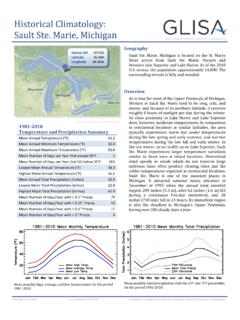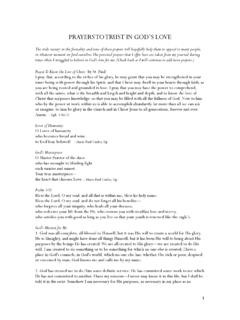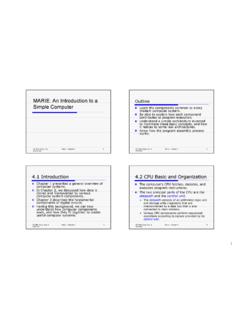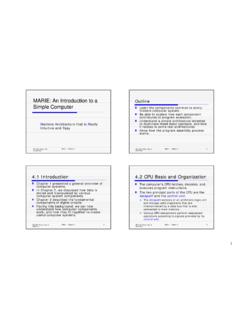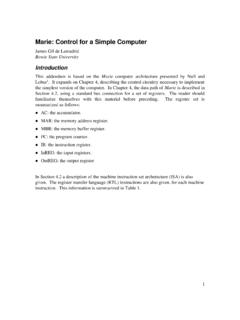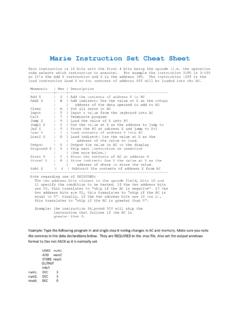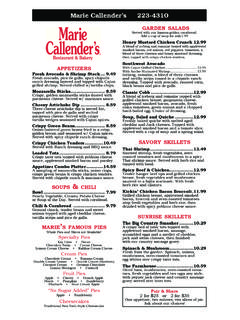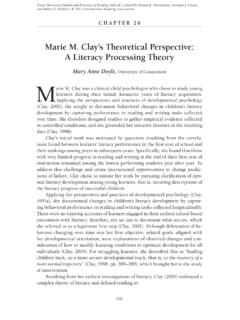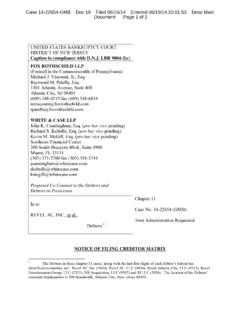Transcription of MarieSim: A Simulator for the MARIE Architecture
1 The Pennsylvania State University The Graduate School Capital College MarieSim: A Simulator for the MARIE Architecture A Master s Paper in Computer Science By Julia M. Lobur 2003 Julia M. Lobur Submitted in Partial Fulfillment of the Requirements for the Degree of Master of Science April 4, 2003 Abstract The purpose of this project is to provide computer Architecture students with an interactive Simulator to deepen their understanding of the workings of a simple computer, MARIE , which is an acronym for a Machine Architecture that is Really Intuitive and Easy. The Simulator environment, MarieSim, presents this machine Architecture in a detailed, yet visually attractive manner.
2 Through interaction with its graphical environment, students can observe how assembly language statements affect the registers and memory of a computer system. The graphical environment for MarieSim is written in Java Swing. The integrated MARIE assembler is written in Java. iiTable of Contents Abstract .. ii iv List of Figures .. v 1 2 A Simple Machine Architecture .. 10 Registers and 10 The Data Path .. 11 The Instruction Set Architecture .. 13 3 Significance for Computer Science 16 4 MarieSim, The MARIE 17 Description .. 17 Design 17 19 5 Future Enhancements and 25 6 Conclusion.
3 27 References .. 28 Appendix User s Guide for MarieSim .. 30 iiiAcknowledgements The Architecture of the MARIE computer is an outgrowth of Dr. Linda Null's considerable experience in teaching computer organization and Architecture to many computer science students. It is also a direct result of her passion for making her lessons clear and accessible. This project would not have been possible without her efforts and guidance, for which I am truly grateful. I am also grateful for the careful review of this work by the members of the committee: Dr. Thang Bui, Dr. Pavel Naumov, and Dr. Qin Ding. ivList of Figures Figure 1: The Pep/7 Simulator .
4 3 Figure 2: The 5 Figure 3: The Ant Debugger .. 7 Figure 4: The Organization of 10 Figure 5: The MARIE Data Path .. 12 Figure 6: The MARIE Instruction Format .. 13 Figure 7: The Complete MARIE Instruction Set with Register Transfer Language .. 14 Figure 8: The MarieSim Graphical Environment .. 20 Figure 9: An Unsuccessful Program Assembly .. 21 Figure 10: A Program Loaded and Ready to 22 Figure 11: Program Execution Modes .. 24 Figure 12: Breakpoint Program Control .. 24 v1 Introduction Computer users and computer software designers have seemingly insatiable desires for improved features, easier interface usability, and faster execution speeds.
5 Thus, to keep pace with market expectations, microcomputer manufacturers continually increase the power of their systems. In many ways, these systems have surpassed the complexity of yesterday s million dollar mainframe systems. While the exponential growth of computing power has been a boon for both the computer user and the computer manufacturer, this trend has virtually eliminated the possibility of using these systems as pedagogical tools. To do so is to run the risk of students becoming mired in a plethora of proprietary details that serve only to obscure their understanding of the essential functions of computer systems. While learning the intimate details of today s systems is undoubtedly a worthy endeavor, the complexity of these machines can easily overwhelm the beginning Architecture student, particularly if he or she does not first possess a firm understanding of the basics of the von Neumann Architecture .
6 The Machine Architecture that is Really Intuitive and Easy, MARIE , was conceived solely to provide this basic understanding. It is an unadorned, yet fully functional von Neumann system complete with an uncomplicated instruction set Architecture and a simple register transfer language. The MARIE Architecture is articulated in The Essentials of Computer Organization and Architecture [1], an introductory textbook for computer science students. Any textbook description of a machine Architecture is necessarily static and two-dimensional. While students may grasp the functions of this machine on an abstract intellectual level, their complete understanding of a system comes only through interacting with it.
7 The MARIE Simulator , MarieSim, provides the opportunity for this interaction. MarieSim is a graphical learning environment that illuminates the operation of the MARIE machine Architecture . Within this environment students can: (1) create and edit MARIE assembly language programs; (2) assemble source code into machine object 1code; (3) run machine code programs; and (4) observe and debug their programs using various tools provided within the Simulator . MarieSim is not unique in its simplicity or in its animated execution environment. There are many such software simulators , each with its own particular focus. (A survey and taxonomy can be found in [2].)
8 Some simulation systems model obsolete computers, such as the PDP-series computers formerly sold by the Digital Electronics Corporation. Others provide exposure to highly sophisticated (and otherwise quite expensive) computers such as multiprocessor systems and quantum computers [3]. Owing to the plethora of freely available simulators , an educator desiring to incorporate one of these tools into the classroom face a daunting task. Clearly, one must keep in mind the appropriateness of the Simulator for the course content and expected sophistication of the students. Thus, a Simulator geared toward high-level language compilers would not be the best choice for an introductory computer Architecture course.
9 Also, a Simulator should provide a gentle learning curve so that students won t become frustrated or spend more time learning Simulator operations than the concepts that the Simulator is designed to impart. In this paper, we describe a Simulator that provides an animated, graphical visualization of a classical von Neumann systems as presented in a first course in computer organization and Architecture for computer science majors. There are many delightful simulators that fall out of this narrow scope, such as those suited to high school students [4] [5] [6], non-computer science majors [7], and more advanced treatments [6] [8]. Among the dozens of graphical Simulator environments appropriate for introductory computer Architecture students, we examined three that are popular within the computer Architecture education community.
10 These simulators are Pep/7, the xComputer, and Ant. 2 Figure 1: The Pep/7 Simulator Pep/7 The Pep/7 Simulator , shown in Figure 1, was written as supporting material for J. Stanley Warford s text, Computer Systems [9]. This book takes a top down approach to computer Architecture , starting at the application level, and descending through the computer level hierarchy to the gate level. Because of this, much of Warford s focus is on system software and assembly language programming. The design of Pep/7 is consistent with Warford s pedagogical objectives. The Simulator is mature software, incorporating many features that are helpful to the student: A student can step through program, one instruction at a time.

